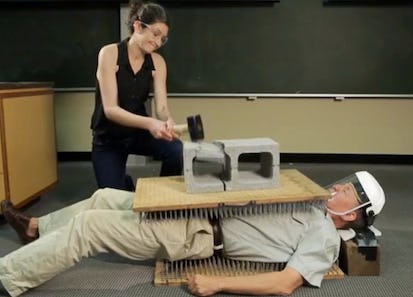- Level Foundation
- المدة 29 ساعات hours
- الطبع بواسطة UNSW Sydney (The University of New South Wales)
-
Offered by

عن
Most of the phenomena in the world around you are, at the fundamental level, based on physics, and much of physics is based on mechanics. Mechanics begins by quantifying motion, and then explaining it in terms of forces, energy and momentum. This allows us to analyse the operation of many familiar phenomena around us, but also the mechanics of planets, stars and galaxies. This on-demand course is recommended for senior high school and beginning university students and anyone with a curiosity about basic physics. (The survey tells us that it's often used by science teachers, too.) The course uses rich multimedia tutorials to present the material: film clips of key experiments, animations and worked example problems, all with a friendly narrator. You'll do a range of interesting practice problems, and in an optional component, you will use your ingenuity to complete at-home experiments using simple, everyday materials. You will need some high-school mathematics: arithmetic, a little algebra, quadratic equations, and the sine, cosine and tangent functions from trigonometry. The course does not use calculus. However, we do provide a study aid introducing the calculus that would accompany this course if it were taught in a university. By studying mechanics in this course, you will understand with greater depth many of the wonders around you in everyday life, in technology and in the universe at large. Meanwhile, we think you'll have some fun, too.الوحدات
Introduction and Basic Tools
6
Assignment
- Start of course survey
- Introduction and Context
- Units and Significant Figures (Important skills in this course!)
- Vectors and Scalars
- Estimating
- Week 1 Test
5
Videos
- Course Welcome
- Lesson 1.1: Introduction and Context
- Lesson 1.2: Units and Significant Figures
- Lesson 1.3: Vectors and Scalars
- Lesson 1.4: Estimating
2
Readings
- Course structure and grading
- Week 1 Study Aids
Velocity and Acceleration
5
Assignment
- Graphing Displacement and Velocity
- Acceleration
- Relating Velocity, Acceleration and Displacement
- Relative Motion
- Week 2 Test
4
Videos
- Lesson 2.1: Graphing Displacement and Velocity
- Lesson 2.2: Acceleration
- Lesson 2.3: Relating Velocity, Acceleration and Displacement
- Lesson 2.4: Relative Motion
1
Readings
- Week 2 Study Aids
Motion in Two Dimensions
5
Assignment
- Projectiles, Falling Vertically Under Gravity
- Combining Vertical and Horizontal Motion
- Trajectories and Range
- Uniform Circular Motion
- Week 3 Test
1
Peer Review
- Accelerations in the Wild (optional)
4
Videos
- Lesson 3.1: Projectiles, Falling Vertically Under Gravity
- Lesson 3.2: Combining Vertical and Horizontal Motion
- Lesson 3.3: Trajectories and Range
- Lesson 3.4: Uniform Circular Motion
1
Readings
- Week 3 Study Aids
Newton's Laws of Motion
6
Assignment
- Newton's Laws of Motion
- Inertial and Non-inertial Frames
- Newton's Third Law
- Calculating Total Force
- Practice Problems
- Week 4 Test
7
Videos
- Lesson 4.1: Newton's Laws of Motion
- Lesson 4.2: Inertial and Non-inertial Frames
- Lesson 4.3: Newton's Third Law
- Lesson 4.4: Calculating Total Force
- Lesson 4.5: Practice Problems
- Historical Interlude
- The Syllogism
1
Readings
- Week 4 Study Aids
Weight, Friction and Spring Forces
5
Assignment
- Weight versus Mass
- Springs and Hooke's Law
- Normal and Frictional Forces
- Friction Problems
- Week 5 Test
4
Videos
- Lesson 5.1: Weight versus Mass
- Lesson 5.2: Springs and Hooke's Law
- Lesson 5.3: Normal and Frictional Forces
- Lesson 5.4: Friction Problems
1
Readings
- Week 5 Study Aids
Work, Energy and Power
6
Assignment
- What is Work?
- Work and Kinetic Energy
- Work and Potential Energy
- Energy Conservation
- Energy, Work and Power
- Week 6 Test
1
Peer Review
- Slip Sliding Away (optional)
5
Videos
- Lesson 6.1: What is Work?
- Lesson 6.2: Work and Kinetic Energy
- Lesson 6.3: Work and Potential Energy
- Lesson 6.4: Energy Conservation
- Lesson 6.5: Energy, Work and Power
1
Readings
- Week 6 Study Aids
Momentum and Collisions
5
Assignment
- Momentum and Collisions
- Impulse and More About Collisions
- Centre of Mass, Elastic and Inelastic Collisions
- Problems Involving Collisions
- Week 7 Test
4
Videos
- Lesson 7.1: Momentum and Collisions
- Lesson 7.2: Impulse and More About Collisions
- Lesson 7.3: Centre of Mass, Elastic and Inelastic Collisions
- Lesson 7.4: Problems Involving Collisions
1
Readings
- Week 7 Study Aids
Gravity
6
Assignment
- Gravity, Orbits, Planets, Stars...
- g Varies with Latitude and Altitude; Gravitational Potential Energy
- Orbits
- Gravity and Other Forces
- Week 8 Test
- End of course survey
5
Videos
- Lesson 8.1: Gravity, Orbits, Planets, Stars...
- Lesson 8.2: g Varies with Latitude and Altitude; Gravitational Potential Energy
- Lesson 8.3: Orbits
- Lesson 8.4: Gravity and Other Forces
- Another Historical Interlude
1
Readings
- Week 8 Study Aids
Auto Summary
Explore the fascinating world of physics with "Mechanics: Motion, Forces, Energy and Gravity, from Particles to Planets." Designed for senior high school and early university students, this engaging course delves into the fundamentals of mechanics using rich multimedia tutorials, animations, and practical experiments. With a focus on real-world phenomena and celestial mechanics, the course requires basic high-school math but no calculus. Taught by Coursera, it offers 1740 minutes of content and is available through Starter and Professional subscriptions. Perfect for curious learners and science teachers alike!

Prof. Joe Wolfe

Dr Elizabeth J. Angstmann

Mr Sebastian Fricke


